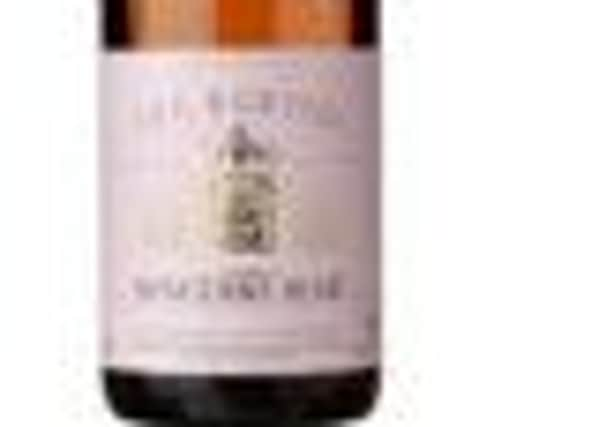Ten rosé wines to try


RHONE, FRANCE: LIRAC LA FERMADE ROSE 2013 Domaine Maby
(£11.95, Yapp Brothers, www.yapp.co.uk)
This is a red wine drinker’s rosé. I loved its very dry palate, piquant spiciness and crunchy red fruits. It has more structure and weight than other rosés, so works a treat matched to spicy oriental dishes, marinated fish or barbecued chicken. A blend of southern French grapes: grenache noir and blanc, cinsault and picpoul from a much-neglected southern Rhone appellation, this is not as well-known as its neighbours Tavel and Châteauneuf du Pape. Quality here is really improving, particularly from Richard Maby’s domaine. Alcohol: 14 per cent STAR BUY
LANGUEDOC, FRANCE: VENDANGES NOCTURNE ROSE 2013 Laurent Miquel
(£6.21 reduced from £8.29, in Waitrose until 9 September)
Advertisement
Hide AdAdvertisement
Hide AdVendange nocturne means the grapes are harvested at night to preserve freshness by picking in the coolest hours, so expect plenty of fresh acid here alongside peppery undertones. This blend of cinsault and syrah is very, very dry, which is what I really look for in a rosé for drinking in the heat as I find many of the warm climate New World rosés are too sweet and soupy for summer quaffing. Alcohol: 12.5 per cent
PROVENCE, FRANCE: COTES DE PROVENCE ST VICTOIRE 2013 Domaine Houchart
(£8.50, The Wine Society, www.thewinesociety.com)
This was the outstanding winner in our tasting and considered best value too. St Victoire is a sub zone of the huge Côtes de Provence appellation. It is more mountainous than coastal, with the dramatic St Victoire range. This four-grape blend (cinsault, grenache, mourvedre and syrah) hails from a 19th-century estate run by the Quiot family, whose ancestor Aurelien was friends with Cézanne, who regularly visited Domaine Houchart near the enchanting village of Puyloubier. Salmon pink, strawberry and cherry fruits, lively acid – a very pretty rosé. Alcohol: 13 per cent STAR BUY
LOIRE, FRANCE: SANCERRE ROSE LES RUETTES 2012
(£12.99, Marks & Spencer)
Our tasters enjoyed the elegant lightness of this rosé. It’s pale in colour, thrillingly crisp with a lovely lightness of touch which would suit those who usually drink sleek, cool climate white wines. Made from pinot noir grown in the ever-popular Sancerre appellation in the Loire, the only snag is that Sancerre rosé is usually so much more expensive in comparison to other rosés on the market. Alcohol: 12.5 per cent
PROVENCE, FRANCE: COTEAUX D’AIX EN PROVENCE HARMONIE DE PROVENCE ‘ORGANIC’ ROSE 2013 Domaine des Oullieres
(£10.75, Yapp Brothers)
From a huge appellation better known for its reds, the dry Mediterranean climate works well for this organic-focused producer north of Aix en Provence where it is based. Famille Ambrosio Collomb uses a mix of Rhône and Provence grapes: mainly red grenache and cabernet sauvignon with a touch of syrah and white vermentino. It’s pale in colour like many Provencal rosés, and dry with a hint of thyme, fennel and subtle red fruit. The taste is light and elegant, despite its high 13 per cent alcohol.
COASTAL REGION, SOUTH AFRICA: KLEINE ZALZE CABERNET SAUVIGNON/SHIRAZ ROSE 2013
(£7.99, Waitrose)
From one of the Cape’s oldest estates near Stellenbosch, Kleine Zalze’s commercial chenin blanc and its Family Reserve range are very good, but this cabernet/shiraz rosé blend is disappointing. Its just off dry style with a pale rose pink colour does have plenty of cherry and plum ripe fruits, and a pretty label, but it’s just not as stylish and balanced as other rosés in our tasting. Alcohol: 14 per cent
SAN ANTONIO, CHILE: LEYDA VALLEY ROSE 2013 Vina Litoral
(£8.95, The Wine Society)
Advertisement
Hide AdAdvertisement
Hide AdThe coastal Leyda valley benefits from sea breezes from the Pacific just a few kilometres away. This is my preferred area for Chilean rosés as they tend to be drier, higher in acid, moderate in alcohol with a hint of brine and salt alongside the bright, lush, raspberry fruits. Other Chilean rosés in our tasting were considered too sweet for summer drinking. Alcohol: 12.5 per cent
RIOJA, SPAIN: MUGA RIOJA ROSADO 2013
(£8.50, The Wine Society; £9.34 each for 2 bts or £10.99 bt, Majestic Wine; £9.99, Waitrose)
Muga is one of my favourite Rioja producers. Based in the old station area of the pretty town of Haro in the Rioja Alta subzone, it sticks to traditional values with a modern take, as you find in this rosé blend made from two red grapes – grenache and tempranillo – with a little white viura added to flesh out the mouthfeel. Alcohol: 13 per cent
NAVARRA, SPAIN: SENORIO DE SARRIA ROSADO 2013
(£6.25, The Wine Society)
Navarra rosés should be better known as they offer much better value than rosés from its neighbour Rioja. The same grenache grape is grown here too; this wine hails from the Valdizarbe zone with a backdrop of the El Perdon mountains as shelter. This has a tutti-frutti sweetness and less acidity, which would appeal to those who like very fruit-driven New World wine styles and those with a sweet tooth. Alcohol: 13.5 per cent
CAMPO DE BORJA, SPAIN: MARQUES DE CRUZ GARNACHA ROSE
(£5.99 reduced from £7.99, in Waitrose until 9 September)
This is made by a Scottish winemaker, Norrel Robertson MW, in a little-known region in Aragon in northern Spain. It’s a region which offers similar styles to Rioja and Navarra – and the same grape garnacha – at knockdown prices, particularly at under £6. You’ll get strawberry fruits, light peppery undertones, hints of vanilla and cinnamon – it’s well made and great value. Alcohol: 14 per cent
Join Rose’s Beginners wine classes in Edinburgh, from £36, www.rosemurraybrown.com